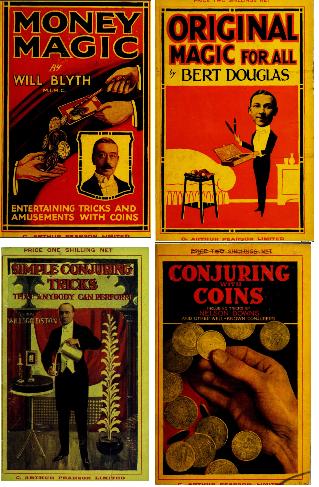Help us get to over 8,755 articles in 2024.
If you know of a magician not listed in MagicPedia, start a New Biography for them. Contact us at magicpediahelp@gmail.com
Yellow Perils: Difference between revisions
mNo edit summary |
mNo edit summary |
||
| Line 1: | Line 1: | ||
[[Yellow Perils]] | [[Yellow Perils]] was the term coined by [[Patrick Playfair]] used to describe the bright yellow pictorial covered books produced by [[C. Arthur Pearson Ltd.]] from London in the early 1900s. Most of them were books on magic and other allied arts. Although Pearson had no real interest in magic, just selling books. The covers of most were bright and clean, the spines however were more often than not ragged, crumbling or just plain missing. [[Image:YellowPerils.jpg|right]] | ||
These books were originally very inexpensive at only one shilling or two shillings a piece. There was debate among magicians at the time if these books offered for sale primarily to the public were considered exposure. Professional magicians starting referring to them as "the yellow perils" because their secrets were being made available so cheaply. | These books were originally very inexpensive at only one shilling or two shillings a piece. There was debate among magicians at the time if these books offered for sale primarily to the public were considered exposure. Professional magicians starting referring to them as "the yellow perils" because their secrets were being made available so cheaply. | ||
Revision as of 06:59, 14 December 2020
Yellow Perils was the term coined by Patrick Playfair used to describe the bright yellow pictorial covered books produced by C. Arthur Pearson Ltd. from London in the early 1900s. Most of them were books on magic and other allied arts. Although Pearson had no real interest in magic, just selling books. The covers of most were bright and clean, the spines however were more often than not ragged, crumbling or just plain missing.
These books were originally very inexpensive at only one shilling or two shillings a piece. There was debate among magicians at the time if these books offered for sale primarily to the public were considered exposure. Professional magicians starting referring to them as "the yellow perils" because their secrets were being made available so cheaply.
Raymond Ricard noted that there were 33 titles published, though not all were related to magic or the allied arts.
These books now are highly sought after by some collectors.
Titles [1]
- The Drawing Room Entertainer by Cecil H. Bullivant (1903)
- Magic Made Easy by David Devant (1903)
- After-Dinner Sleights and Pocket Tricks by C. Lang Neil (1904)
- Modern Card Manipulation by C. Lang Neil (1906)
- Tricks for Everyone by David Devant (1910)
- The New Book of Puzzles by C. Arthur Pearson (1911)
- Indoor Games for Children and Young People by E. M. Baker (1912)
- Simple Conjuring Tricks by Will Goldston (1913)
- The Complete Book of Hand Shadows by Louis Nikola (1913)
- Card Tricks without Sleight of Hand or Apparatus by L. Widdop (1914)
- Conjuring with Coins by T. Nelson Downs edited by Nathan Dean (1916)
- Pearson's Humorous Reciter (1918)
- Fun on the Billiard Table by Stancliffe (1919)
- Paper Magic by Will Blyth (1920)
- Chemical Magic by V. E. Johnson (1920)
- Match-Stick Magic by Will Blyth (1921)
- Ventriloquism and Juggling by Harold C. King & E. T. John (1921)
- Handkerchief Magic by Will Blyth (1922)
- Water Wizardry by Arthur Ainslie (1922)
- Have You Heard this One? by Charles Vivian (1922)
- More Paper Magic by Will Blyth (1923)
- Simplified Conjuring for All by Norman Hunter (1923)
- The Pearson Puzzle Book by by Mr X (1923)
- Impromptu Conjuring Without Apparatus by Will Blyth (1924)
- The Amateur Performer by W. J. Seymour (1924)
- My Mysteries by Ivor C. Smith (1924)
- New And Easy Magic by Norman Hunter (1925)
- Money Magic - Entertaining Tricks & Amusements with Coins by Will Blyth (1926)
- Original Magic for All by Bert Douglas (1927)
- Broadcast Conjuring Tricks by Cyril Shields (1930)
- The Best Tricks and How to Do Them by David Devant (1931)
- Pearson Puzzle Book by J. K. Benson
- Pearson's Book of Fun, Mirth & Mystery by Mr X
References
- Leat's Leaflets No. 2
- James Findlay "yellow perils" article for Magicol #29.
- ↑ Yellow Perils by Raymond Ricard in Perennial Mystics No. 16 (2001)
